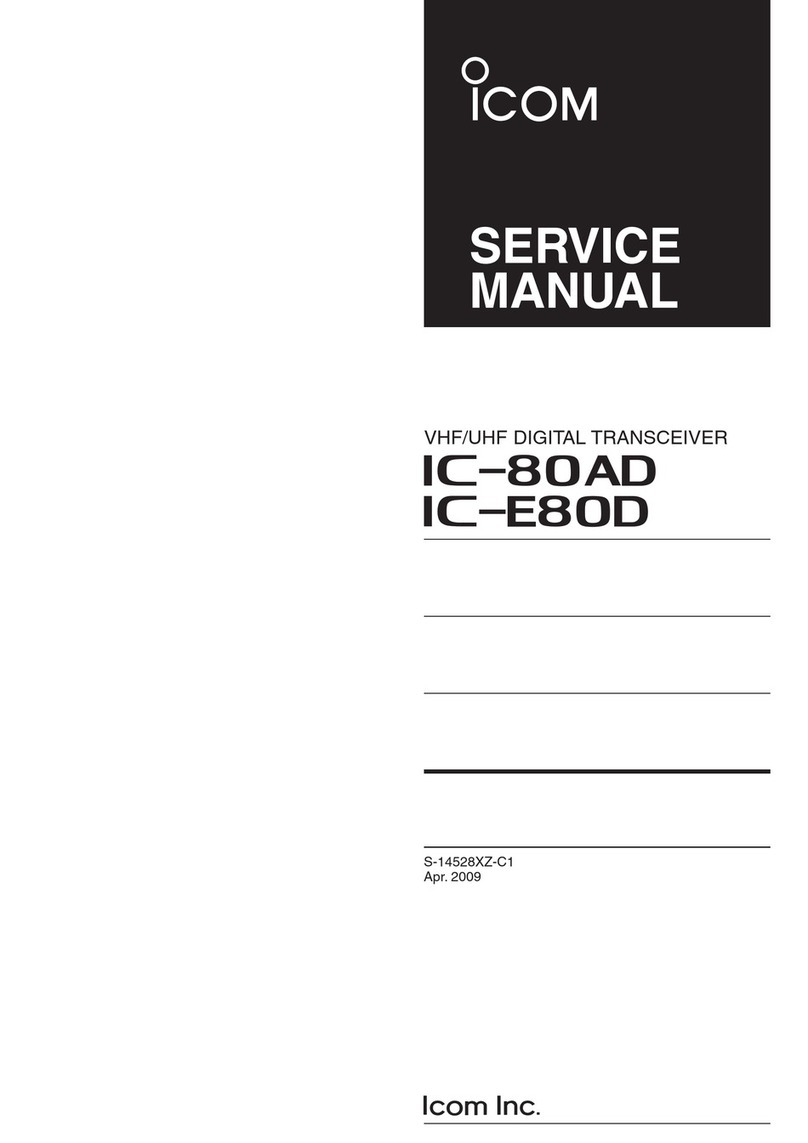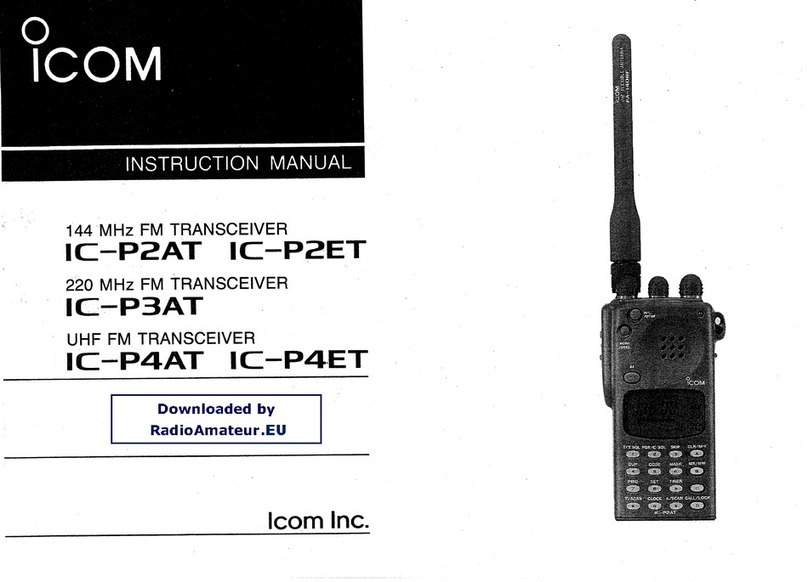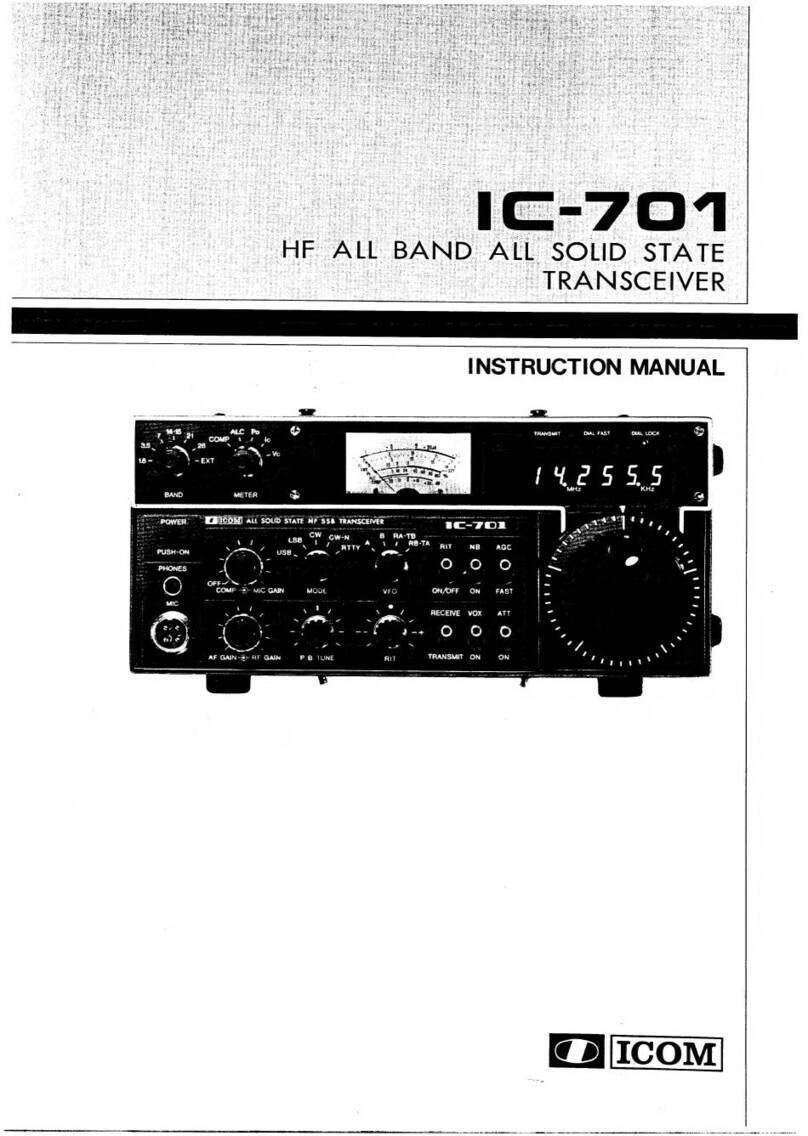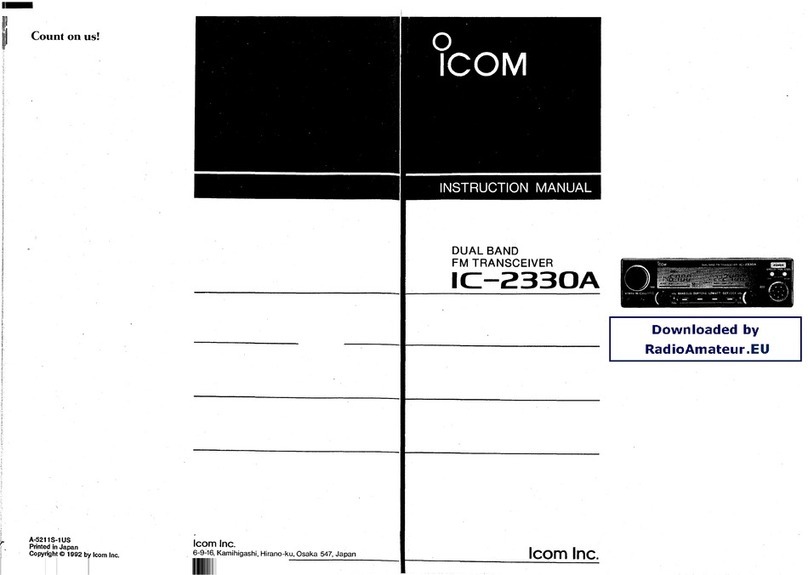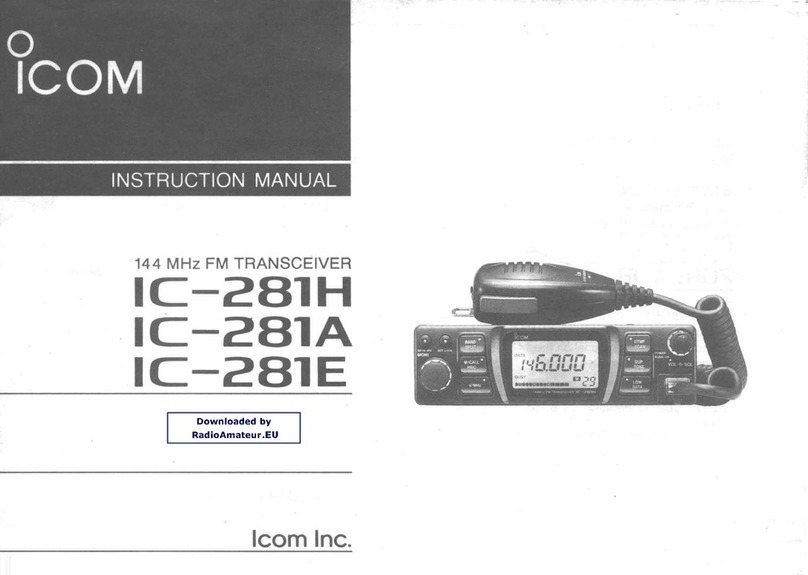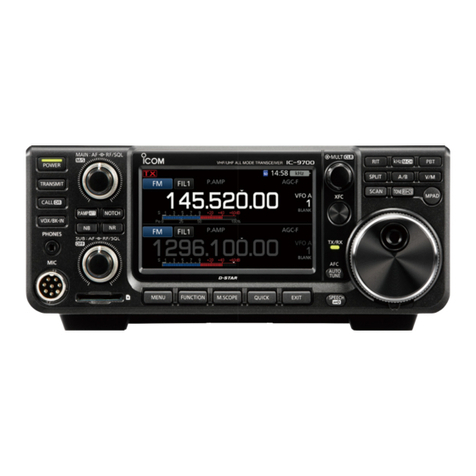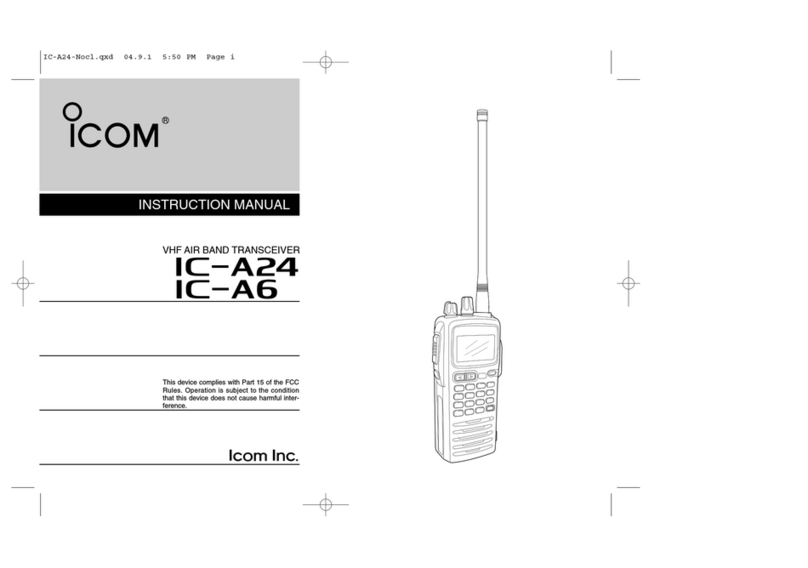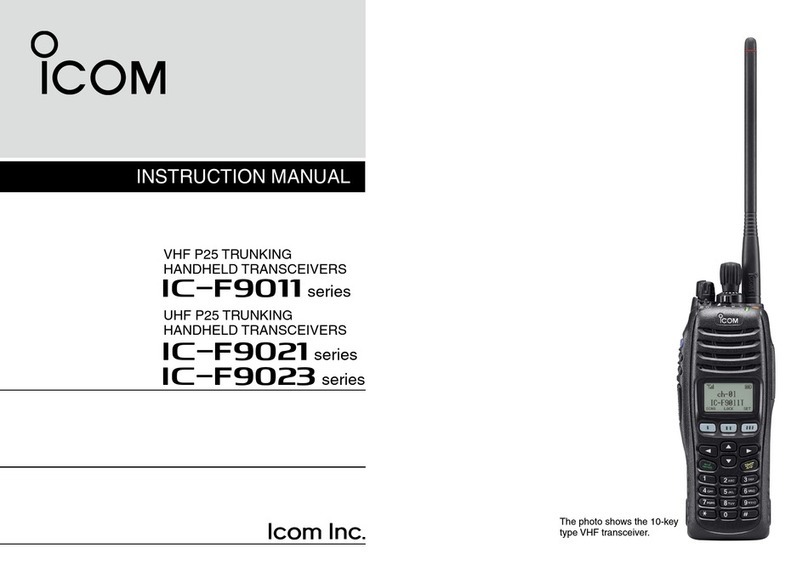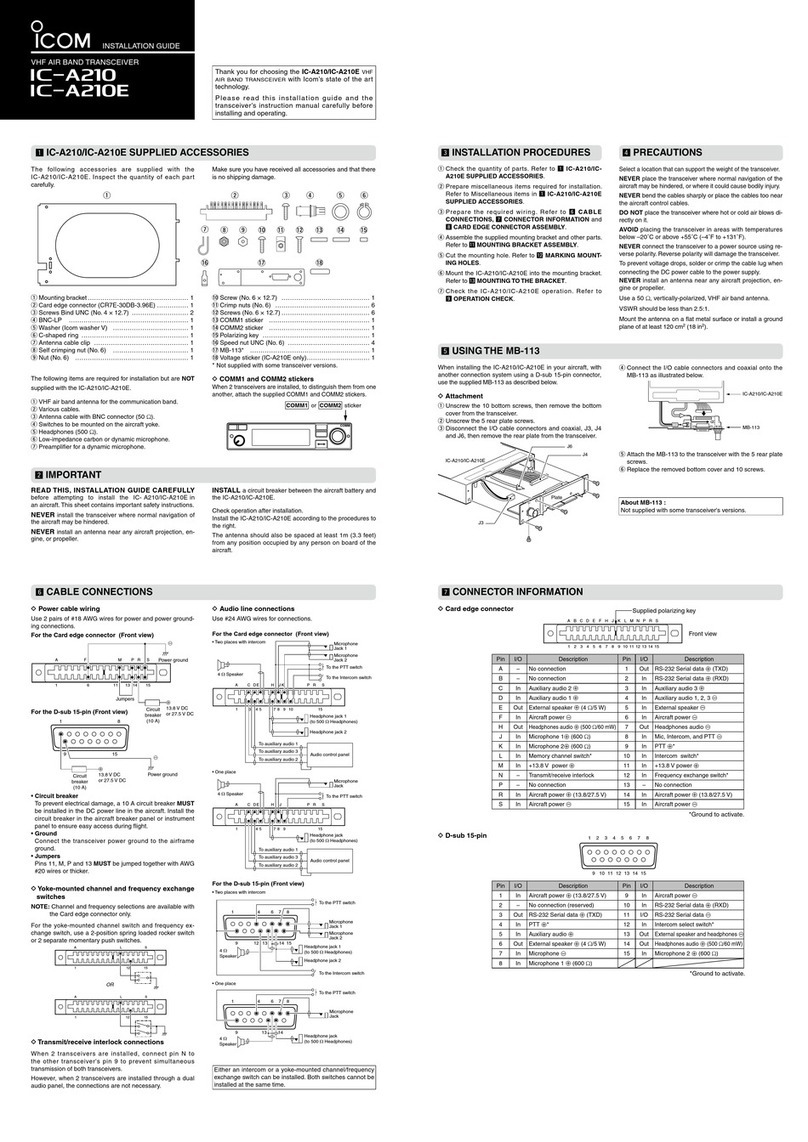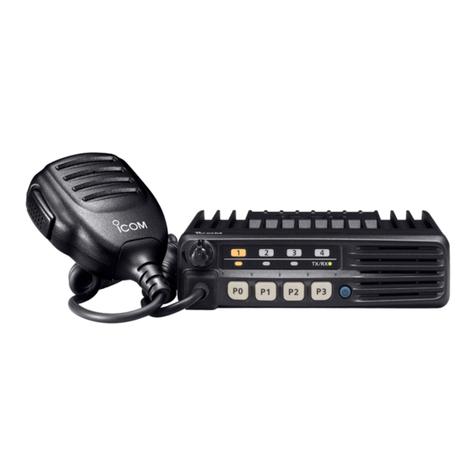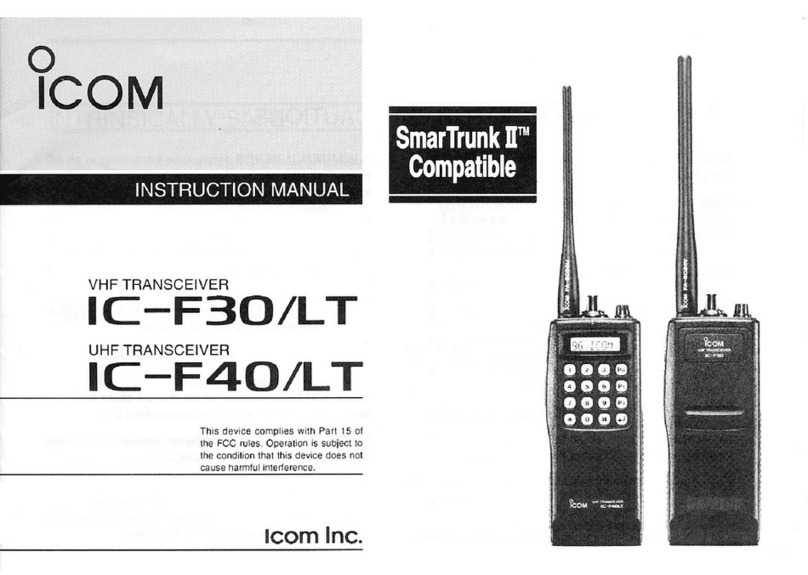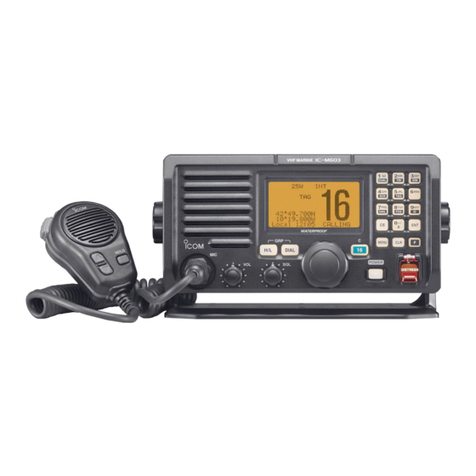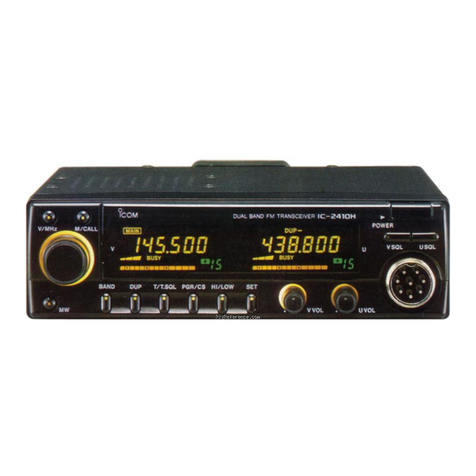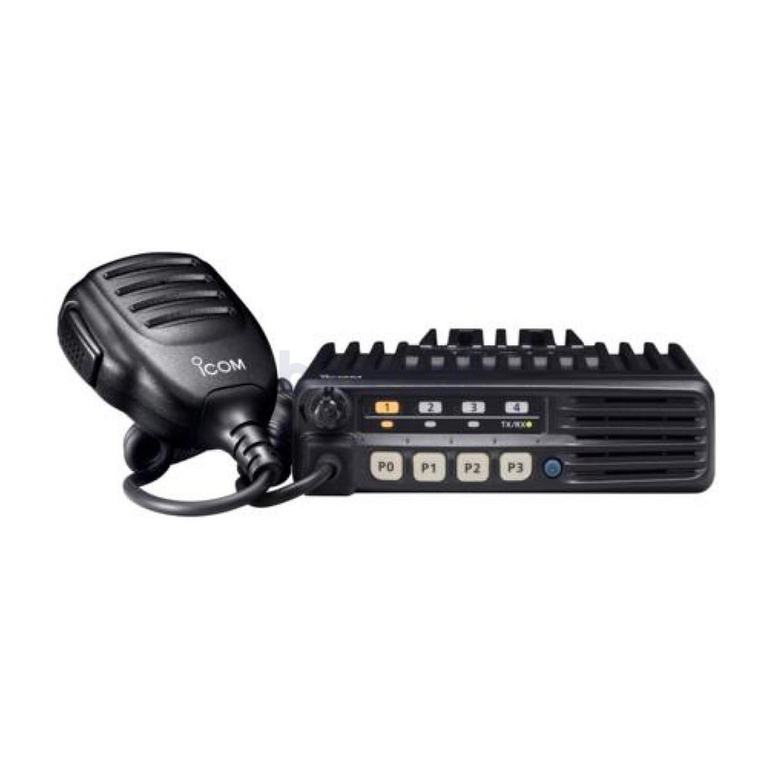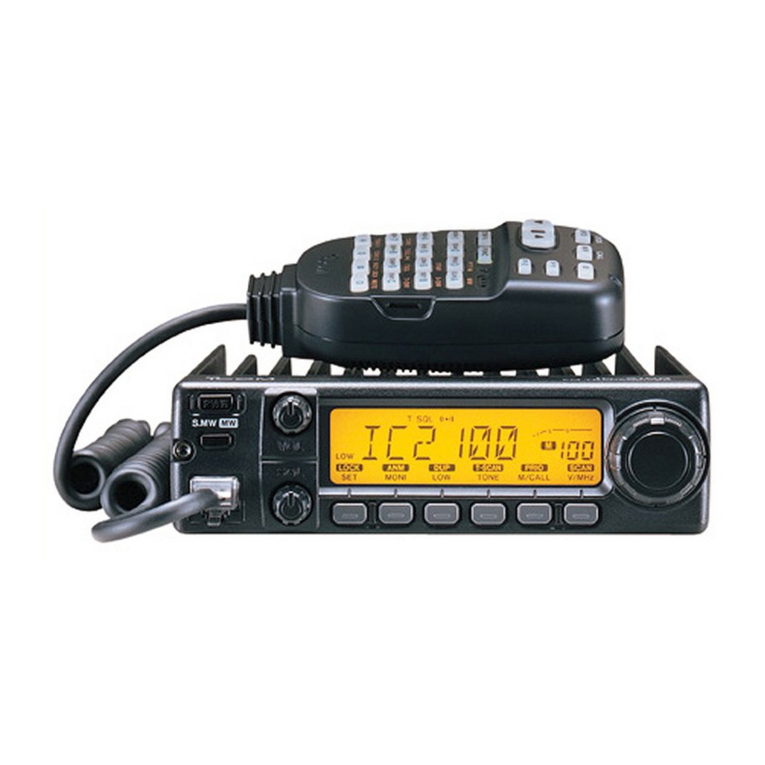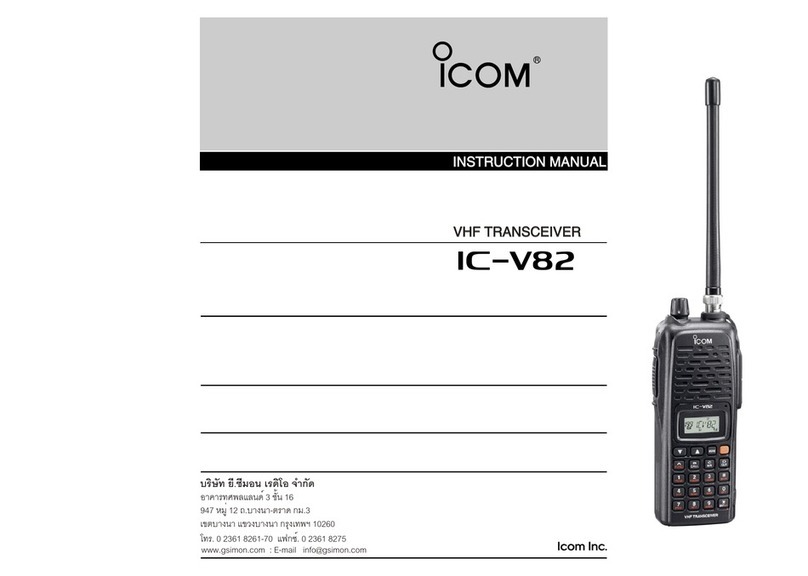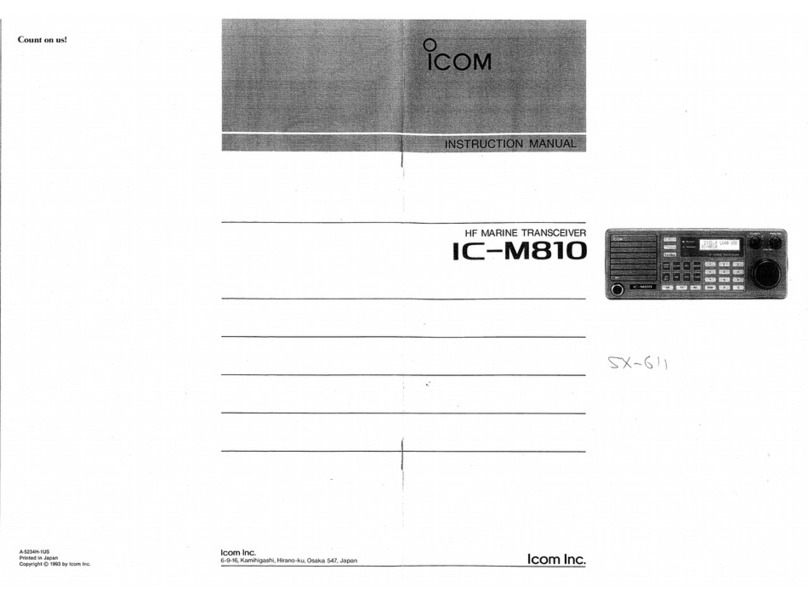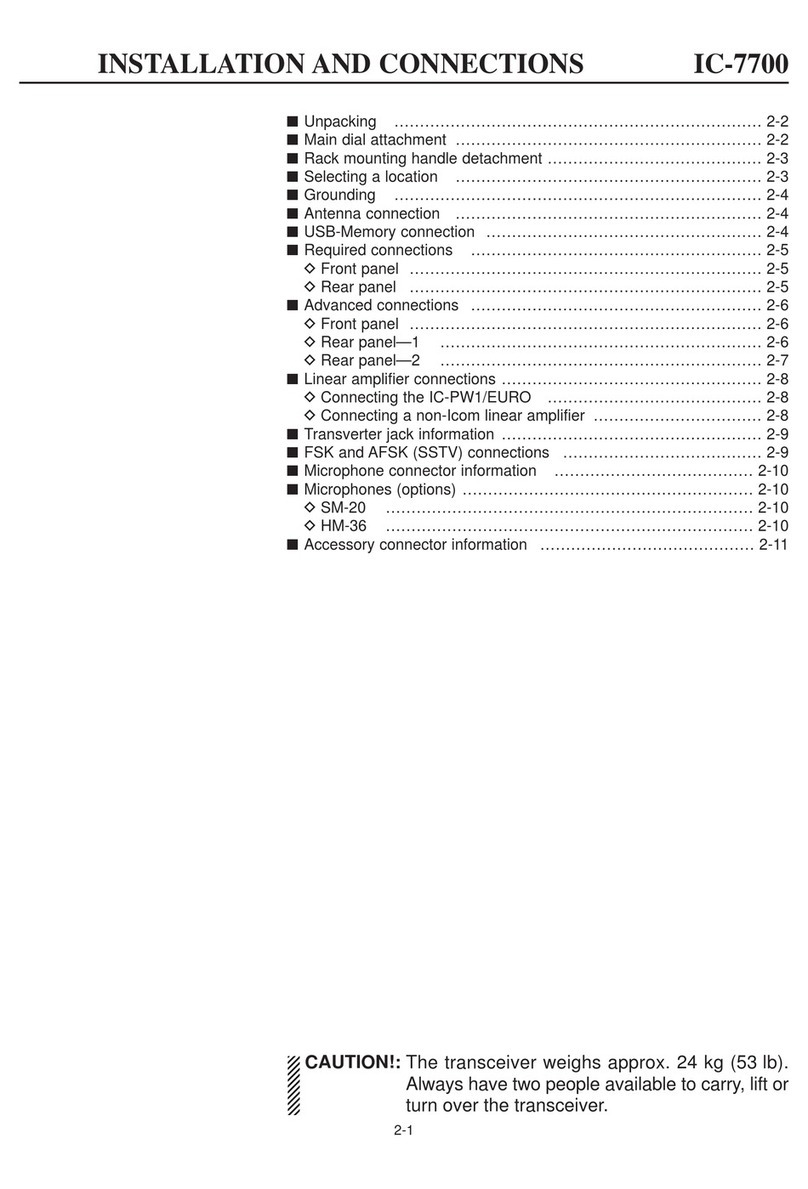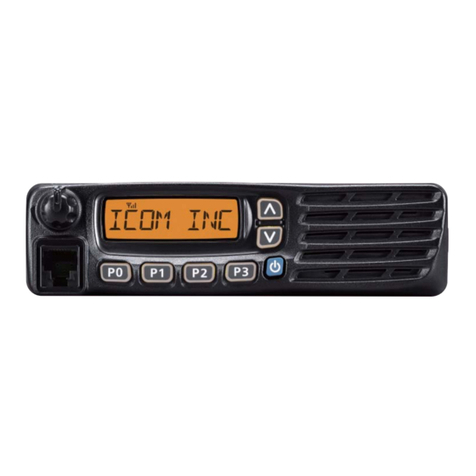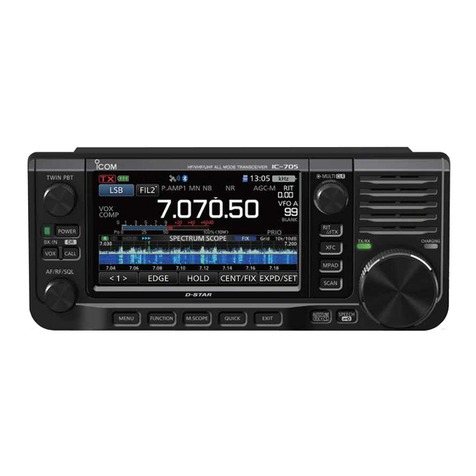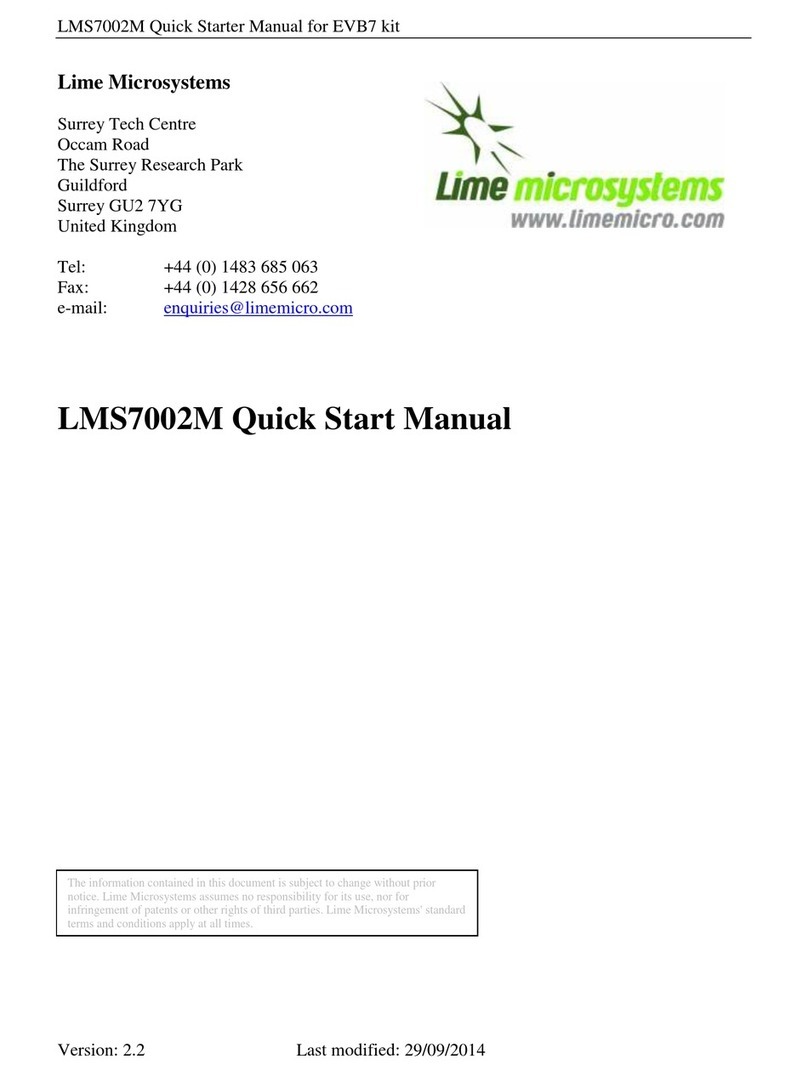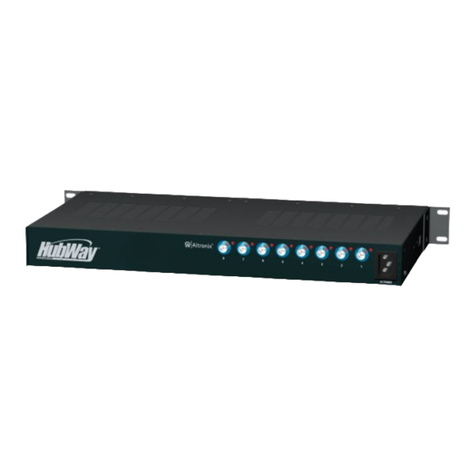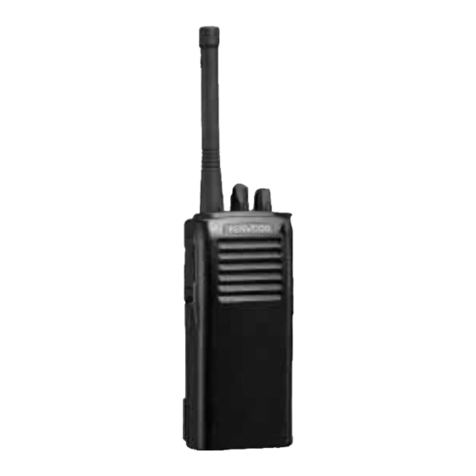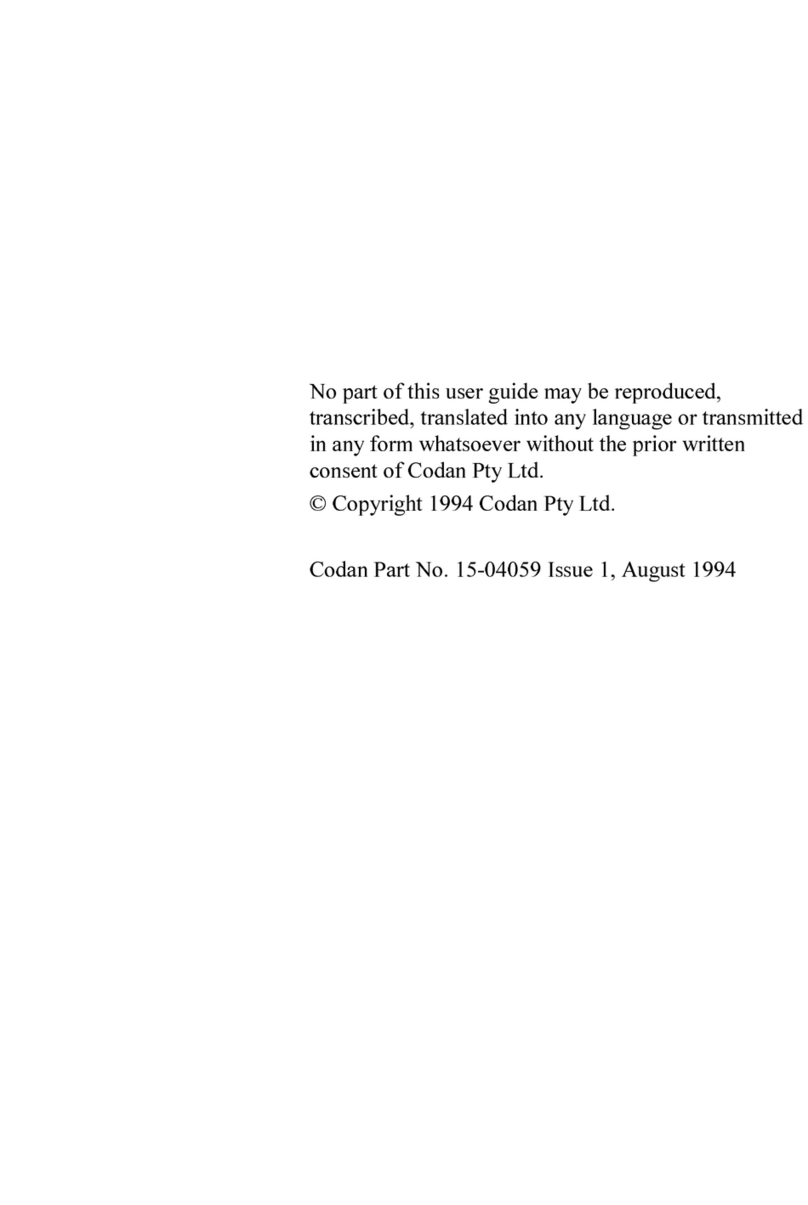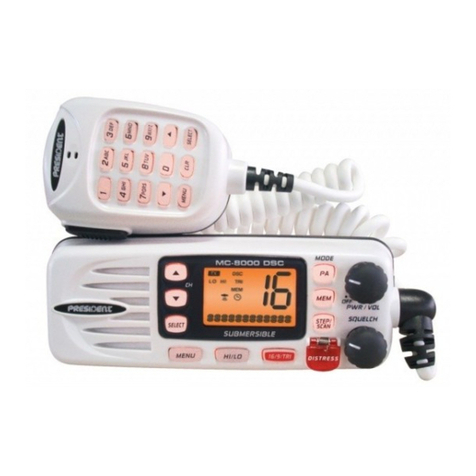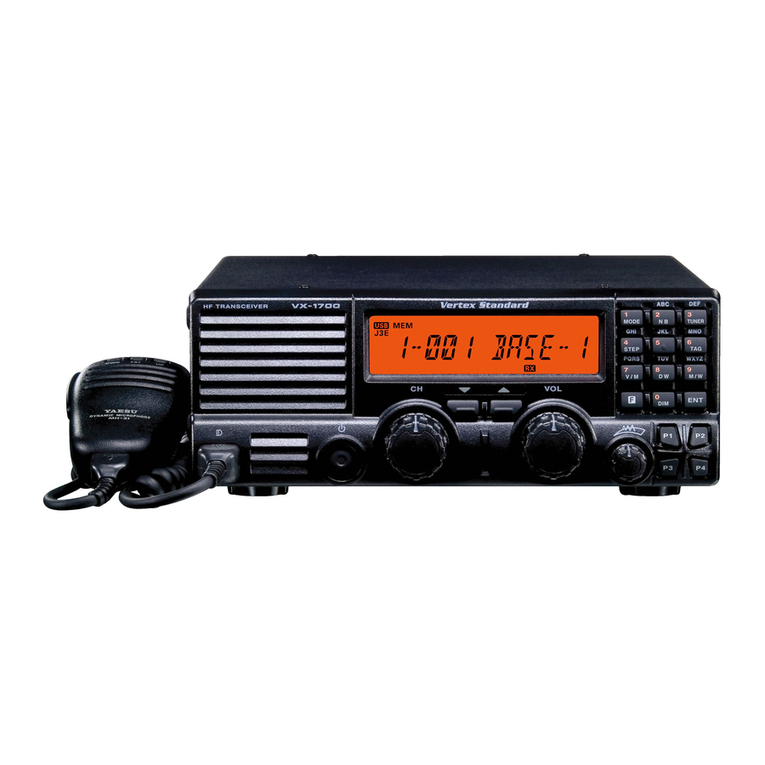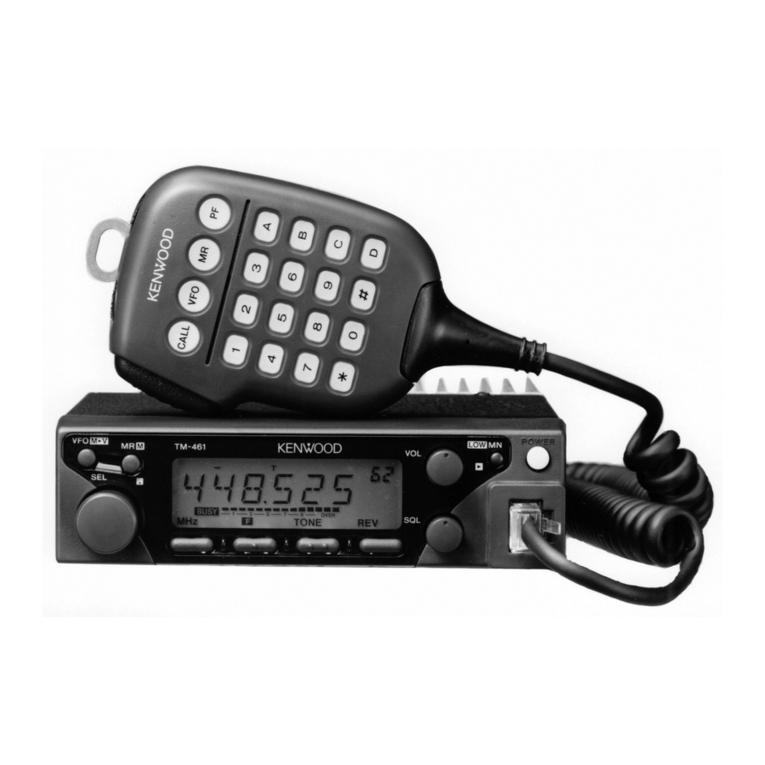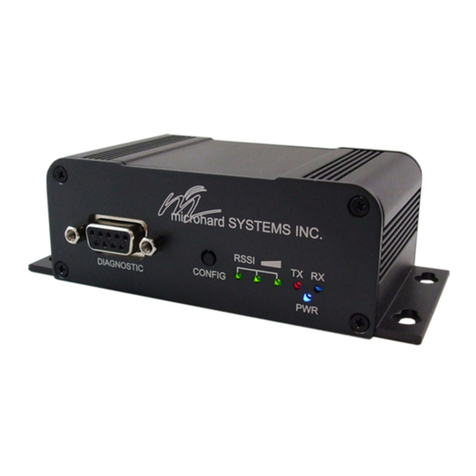Icom IC-706MKIIG User manual

INSTRUCTION MANUAL
i706MK™G
HF/VHF/UHF ALL MODE TRANSCEIVER
This device complies with Part 15 of the FCC rules. Operation is subject
to the following two conditions: (1)This device may not cause harmful in-
terference, and (2) this device must accept any interference received,
including interference that may cause undesired operation.
IC-706MKIIG.qxd 02.3.27 13:53 Page 1

EXPLICIT DEFINITIONS
PRECAUTIONS
IMPORTANT
RReeaadd tthhiiss iinnssttrruuccttiioonn mmaannuuaall ccaarreeffuullllyy
before attempting to operate the transceiver.
SSaavvee tthhiiss iinnssttrruuccttiioonn mmaannuuaall..
This instruction
manual contains important safety and operating
instructions for the IC-706MKIIG.
RWWAARRNNIINNGG HHIIGGHH VVOOLLTTAAGG!! NNVVRR
attach an antenna or internal antenna connector dur-
ing transmission. This may result in an electrical shock
or burn.
RNNVVRRapply AC to the [DC13.8V] socket on the
transceiver rear panel. This could cause a fire or ruin
the transceiver.
RNNVVRRapply more than 16 V DC, such as a 24 V
battery, to the [DC13.8V] socket on the transceiver
rear panel. This could cause a fire or ruin the transceiv-
er.
RNNVVRRlet metal, wire or other objects touch any
internal part or connectors on the rear panel of the
transceiver. This will cause electric shock.
RNNVVRRexpose the transceiver to rain, snow or
any liquids.
NNVVRR allow children to play with the transceiver.
AAVVOOIIDD using or placing the transceiver in areas with
temperatures below –10°C (+14°F) or above +60°C
(+140°F). Be aware that temperatures on a vehicle’s
dashboard can exceed 80°C, resulting in permanent
damage to the transceiver’s front panel if left there for
extended periods.
AAVVOOIIDD placing the transceiver in excessively dusty
environments or in direct sunlight.
AAVVOOIIDD placing the transceiver against walls or putting
anything on top of the transceiver. This will obstruct
heat dissipation.
During mobile operation, DDOO NNOOTToperate the trans-
ceiver without running the vehicle’s engine. When
transceiver power is ON and your vehicle’s engine is
OFF, the vehicle’s battery will soon become exhausted.
Make sure the transceiver power is OFF before start-
ing the vehicle. This will avoid possible damage to the
transceiver by ignition voltage spikes.
During maritime mobile operation, keep the transceiv-
er and microphone as far away as possible from the
magnetic navigation compass to prevent erroneous
indications.
BB CCAARRFFUULL!!
The heatsink will become hot when
operating the transceiver continuously for long peri-
ods.
BB CCAARRFFUULL!!If a linear amplifier is connected, set
the transceiver’s RF output power to less than the lin-
ear amplifier’s maximum input level, otherwise, the lin-
ear amplifier will be damaged.
Use Icom microphones only (supplied or optional).
Other manufacturer’s microphones have different pin
assignments and connection to the IC-706MKIIG may
damage the transceiver.
Beat signals may be heard on some frequencies.
These will occur as a result of circuit construction.
For U.S.A. only
CCaauuttiioonn::Changes or modifications to this transceiver, not
expressly approved by Icom Inc., could void your authority
to operate this transceiver under FCC regulations.
i
The explicit definitions described below apply to this
instruction manual.
WWOORRDDDDFFIINNIITTIIOONN
RWWAARRNNIINNGGPersonal injury, fire hazard or electric
shock may occur.
CCAAUUTTIIOONNEquipment damage may occur.
NNOOTTIf disregarded, inconvenience only. No risk
of personal injury, fire or electric shock.
IC-706MKIIG.qxd 02.3.27 13:53 Page i

TABLE OF CONTENTS
IMPORTANT …………………………………………… i
PRECAUTIONS …………………………………………i
EXPLICIT DEFINITIONS ……………………………… i
TABLE OF CONTENTS ……………………………… ii
UNPACKING ……………………………………………ii
11PPAANNLL DDSSCCRRIIPPTTIIOONN……………………… 11––88
■Front panel ……………………………………………… 1
■Function switches ……………………………………… 3
■Rear and side panels ………………………………… 5
■Function display ……………………………………… 7
■Microphone (HM-103) ………………………………… 8
22IINNSSTTAALLLLAATTIIOONN AANNDD CCOONNNNCCTTIIOONNSS…99––1144
■Unpacking ……………………………………………… 9
■Grounding ……………………………………………… 9
■Antenna …………………………………………………9
■Installation………………………………………………10
■Required connections …………………………………11
■Advanced connections ………………………………12
■Power supply connections ……………………………13
■External antenna tuners and linear amplifier ………14
33FFRRQQUUNNCCYY SSTTTTIINNGG……………………1155––1199
■When first applying power (CPU resetting) ………… 15
■Initial settings ………………………………………… 15
■VFO description ……………………………………… 16
■Frequency setting …………………………………… 17
■Mode selection …………………………………………19
44RRCCIIVV AANNDD TTRRAANNSSMMIITT……………… 2200––3388
■Functions for receive ………………………………… 20
■Functions for transmit ……………………………… 25
■Split frequency operation …………………………… 29
■Tone squelch operation ……………………………… 31
■Tone scan operation ………………………………… 31
■One-touch repeater ………………………………… 32
■Auto repeater function ……………………………… 32
■Functions for CW ……………………………………… 33
■Functions for RTTY …………………………………… 35
■Packet operation ……………………………………… 37
■SWR …………………………………………………… 38
55MMMMOORRYY AANNDD SSCCAANN OOPPRRAATTIIOONN…… 3399––4444
■Memory channels …………………………………… 39
■Memory channel selection …………………………… 39
■Memory clearing ……………………………………… 39
■Memory/call programming …………………………… 40
■Frequency transferring ……………………………… 41
■Memory names ……………………………………… 41
■Memo pads …………………………………………… 42
■Scan types …………………………………………… 43
■Preparation …………………………………………… 43
■Programmed scan operation ………………………… 44
■Memory scan operation ……………………………… 44
■Select memory scan operation ……………………… 44
■Priority watch ………………………………………… 44
66
RRMMOOTT JJAACCKK ((CCII--VV)) IINNFFOORRMMAATTIIOONN
…4455––4466
77SSTT MMOODD…………………………………… 4477––5555
■General ………………………………………………… 47
■Quick set mode items ………………………………… 48
■Initial set mode items ………………………………… 50
88MMAAIINNTTNNAANNCC………………………………… 5566
■Fuse replacement …………………………………… 56
■Memory backup ……………………………………… 56
■Cleaning ……………………………………………… 56
99TTRROOUUBBLLSSHHOOOOTTIINNGG…………………… 5577––5588
1100
OOPPTTIIOONNAALL IINNSSTTAALLLLAATTIIOONNSS//SSTTTTIINNGGSS
…5599––6622
■Opening the transceiver case ……………………… 59
■UT-102
VOICE SYNTHESIZER UNIT
……………………… 59
■CR-282
HIGH
-
STABILITY CRYSTAL UNIT
………………… 60
■IF filters ………………………………………………… 60
■UT-106
DSP RECEIVER UNIT
…………………………… 61
■MB-72
CARRYING HANDLE
……………………………… 61
■AT-180 internal switch description ………………… 62
1111 IINNTTRRNNAALL VVIIWWSS…………………………… 6633
1122OOPPTTIIOONNSS…………………………………… 6644––6655
1133SSPPCCIIFFIICCAATTIIOONNSS…………………………… 6666
1144MMNNUU GGUUIIDD……………………………… 6677––6688
ii
UNPACKING
AAcccceessssoorriieess iinncclluuddeedd wwiitthh tthhee IICC--770066MMKKIIIIGG::
QQttyy..
qDC power cable*.................................................1
wHand microphone (HM-103) ................................1
eSpare fuse (30 A) ...............................................2
rSpare fuse (4 A) .................................................1
tRTTY key plug....................................................1
yElectronic keyer plug ..........................................1
uACC cable..........................................................1
iFerrite bead**.....................................................1
*OPC-639 for Europe versions (differs from the diagram at
left), OPC-025D for other versions.
**Not supplied with some versions.
q
w
er
yt
ui
IC-706MKIIG.qxd 02.3.27 13:53 Page ii

■FFrroonntt ppaanneell
qPPOOWWRR SSWWIITTCCHH [[PPOOWWRR]] (p. 15)
Turns power ON and OFF.
•Push momentarily to turn power ON.
•Push for 2 sec. to turn power OFF.
wAAFF GGAAIINN CCOONNTTRROOLL [[AAFF]] (inner control; p. 15)
Rotate clockwise to increase the audio output from
the speaker; rotate counterclockwise to decrease
the audio output from the speaker.
eRRFF GGAAIINN CCOONNTTRROOLL//SSQQUULLCCHH CCOONNTTRROOLL
[[RRFF//SSQQLL]] (outer control; p. 22)
➥Adjusts the squelch threshold level (to mute
noise when receiving no signal) in all modes.
➥This control can be used for RF gain control to
adjust receiver gain manually.
•RF gain selection can be set in initial set mode (p. 50).
• RF gain is usable in SSB/CW/RTTY modes only.
rFFUUNNCCTTIIOONN DDIISSPPLLAAYY
Shows the operating frequency, dot matrix indica-
tions, selected memory channel, etc. See p. 7 for
details.
tTTUUNNIINNGG SSTTPP SSWWIITTCCHH [[TTSS]] ((pgs. 17, 18)
➥Push momentarily to cycle between 1 Hz/10 Hz,
programmable and 1 MHz tuning steps.
•1 and 10 Hz steps are only available in SSB, CW and
RTTY modes; 1 MHz steps are only available in FM,
WFM and AM modes.
➥Push for 2 sec. to toggle between 1 and 10 Hz
steps, or; when the programmable tuning steps is
indicated, push for 2 sec. to enter programmable
tuning step mode.
yMMOODD SSWWIITTCCHH [[MMOODD]] (p. 19)
➥Push momentarily to cycle through the operating
modes:
USB/LSB ➧CW/CWå➧RTTY/åRTTY ➧
➧FM/WFM/AM
➥Push and hold for 2 sec. to toggle between the
following operating modes:
USB ↔LSB
CW ↔CWå
RTTY ↔åRTTY
FM →WFM →AM →FM, etc.
u
RRCCIIVV//TTRRAANNSSMMIITT IINNDDIICCAATTOORRSS [[RRXX]]//[[TTXX]]
[RX] lights green while receiving (and squelch
opens); [TX] lights red while transmitting.
iMMAAIINN DDIIAALL
Changes the displayed frequency, selects initial set
mode items, etc.
o
UUPP//DDOOWWNN ((BBAANNDD)) SSWWIITTCCHHSS [[Y//Z((BBAANNDD))]]
➥Push to select a band.
•Can also be used to advance quick set mode items,
initial set mode items, etc.
➥Push and hold to scroll through the bands con-
tinuously.
!0 MMAAIINN DDIIAALL TTNNSSIIOONN LLAATTCCHH
Selects the main dial tension.
•2 positions are available.
!1 MMIICCRROOPPHHOONN CCOONNNNCCTTOORR (p. 8)
Modular-type microphone connector—connects
the supplied microphone (HM-103).
•The optional OPC-589 can be used to connect an 8-pin
microphone such as the SM-8 or SM-20, if desired.
•A microphone connector is also available on the rear
1
1PPAANNLL DDSSCCRRIIPPTTIIOONN
HF/VHF/UHF TRANSCEIVER i706MK™G
AF
RIT/
SUB
MENU F-1 F-2 F-3
MODE
BAND
BAND
Y
Z
TS
DISPLAY
LOCK
RX
TX
M-CH
PHONES
TUNER/CALL
P.AMP/ATT
POWER
SHIFT
RF/SQL
q
w e rtyio
o
!1
!2!3!4!5!6!7!8
!9
@0
@2
@1 !0
u
CH
VFO A
P
O
S1
5
53792040
10
60dB
USB
M1 SPL A/B A=B
IC-706MKIIG.qxd 02.3.27 13:53 Page 1

2
1
PANEL DESCRIPTION
panel. DO NOT connect 2 microphones simultaneously.
!2 LLOOCCKK SSWWIITTCCHH [[LLOOCCKK]]
➥Push momentarily to turn the dial lock function
ON and OFF.
•The dial lock function electronically locks the main
dial.
➥When the optional UT-102
VOICE SYNTHESIZER
UNIT
is installed (p. 52), push for 2 sec. to have the
frequency, etc. announced.
•UT-102 operation can be adjusted in initial set mode
(pgs. 53, 54).
!3 DDIISSPPLLAAYY SSWWIITTCCHH [[DDIISSPP]] (p. 68)
➥Push momentarily to select one of the three
menu sets: M1 to M4, S1 to S4 and G1 to G4.
➥Push for 2 sec. to select quick set mode.
!4
FFUUNNCCTTIIOONN SSWWIITTCCHHSS [[FF11]]//[[FF22]]//[[FF33]] (pgs. 3, 4, 68)
Push to select the function indicated in the dot
matrix display above these switches.
•Functions vary depending on the menu set selected.
!5 MMNNUU SSWWIITTCCHH [[MMNNUU]] (p. 68)
➥
P
ush this switch one or more times to select
menus within a menu set (M, Sor G), or push to
advance through the quick set mode and initial
set mode displays.
➥Push and hold to jump between two different
function menu sets.
!6 RRIITT//SSUUBB DDIIAALL SSWWIITTCCHH [[RRIITT//SSUUBB]] (p. 20)
➥Push to toggle the RIT or SUB DIAL function ON
and OFF—initial set mode is used to select the
desired action*.
•Lights green when the SUB DIAL function is ON;
lights red when the RIT function is ON.
•Use the [M-CH] control to vary the RIT frequency or
SUB DIAL frequency (see above).
➥When the RIT function is ON, push for 2 sec. to
add or subtract the shifted frequency to the oper-
ating frequency.
*Even if RIT is selected in initial set mode, RIT cannot be
selected when operating AM, FM or WFM modes.
!7
SSHHIIFFTT CCOONNTTRROOLL [[SSHHIIFFTT]] (outer control; p. 20)
Shifts the center frequency of the receiver’s IF
passband.
•Rotate the control clockwise to shift the center frequen-
cy higher, or rotate the control counterclockwise to shift
the center frequency lower.
•When the graphic menu display (G2) is selected, the IF
passband is graphically displayed and changes in
accordance with the [SHIFT] control (see p. 20).
!8 MM--CCHH CCOONNTTRROOLL [[MM--CCHH]] (inner control)
➥
When the RIT or SUBDIAL functions are OFF,
rotate to select a memory channel number (p. 35).
➥Shifts the receive frequency while the RIT func-
tion is ON in SSB, CW and RTTY modes (see
below and p. 20).
•RIT variable range is ± 9.99 kHz
➥Changes the operating frequency in the select-
ed tuning steps while the SUB DIAL function is
ON (p. 18).
!9 HHAADDPPHHOONN JJAACCKK [[PPHHOONNSS]] (p. 12)
Accepts headphones with 4–16 Ωimpedance.
•When headphones are connected, no receive audio
comes from the speaker.
•When the PHONES/SPEAKER switch on the back of the
front panel is set to the [SPEAKER] position, an external
speaker can be connected. This is convenient for mobile
or outdoor operation.
@0 TTUUNNRR//CCAALLLL SSWWIITTCCHH [[TTUUNNRR//CCAALLLL]]
(pgs. 26, 27)
➥During HF/50 MHz operation, push this switch
momentarily to toggle the automatic antenna
tuner function ON/OFF.
•An optional antenna tuner must be connected.
➥During HF/50 MHz operation, push this switch for
2 sec. to manually tune the antenna.
•An optional antenna tuner must be connected.
➥During 144/430 MHz operation, push this switch
momentarily to select the call channel (or the pre-
vious channel/frequency when the call channel is
already selected). (p. 39)
•“C1” is the 144 MHz call channel and “C2” is the 430
MHz call channel.
@1
FFRROONNTT PPAANNLL LLAATTCCHH (p. 10)
Pull away from the transceiver (towards yourself
when looking at the front of the transceiver) to
detach the front panel from the main body of the
transceiver.
@2
PPRRAAMMPP//AATTTTNNUUAATTOORR SSWWIITTCCHH [[PP..AAMMPP//AATTTT]]
(p. 21)
➥Push momentarily to turn the preamp ON or OFF.
➥Push and hold to turn the 20 dB attenuator ON;
push momentarily to turn the attenuator OFF.
•Lights green when the preamp is ON; lights red when
the 20 dB attenuator is ON.
LOCK
Lights while the lock
function is activated.
RIT
SUB
Lights red while the RIT function is activated;
green while the SUB DIAL function is activated.
TUNER/CALL
Lights while the automatic
tuning function is activated.
P.AMP/ATT
Lights green while the preamp is activated;
lights red while the attenuator is activated.
IC-706MKIIG.qxd 02.3.27 13:53 Page 2

■FFuunnccttiioonn sswwiittcchheess
DMM11 FFUUNNCCTTIIOONNSS
SSPPLLIITT OOPPRRAATTIIOONN (p. 29)
Toggles the split function ON and OFF.
•“ä”appears when the split function is ON.
•The function of [F-3] changes to XFC when the
split function is ON.
VVFFOO AA//BB SSLLCCTTIIOONN(p. 16)
➥Toggles between VFO A and VFO B in
VFO mode.
➥Toggles between transmission VFO and
reception VFO during split operation.
➥Toggles between the transmit and
receive frequencies (and modes) of
memory channels when the split func-
tion is turned ON.
VVFFOO QQUUAALLIIZZAATTIIOONN (p. 16)
Equalizes the frequency and operating
mode of the two VFO’s.
•The rear (undisplayed) frequency and operat-
ing mode are equalized to the front (displayed)
VFO frequency and operating mode.
TTRRAANNSSMMIITT FFRRQQUUNNCCYY CCHHCCKK (p. 29)
Appears when the split function is turned
ON—monitors the transmit frequency
when pushed and held.
•While pushed, the transmit frequency can be
changed with the main dial.
DMM22 FFUUNNCCTTIIOONNSS
MMMMOORRYY WWRRIITT (p. 40)
Stores the displayed frequency and oper-
ating mode into the displayed memory
channel.
MMMMOORRYY TTRRAANNSSFFRR (p. 41)
Transfers the frequency and operating
mode in the selected memory channel to a
VFO.
VVFFOO//MMMMOORRYY (p. 39)
Toggles between VFO and memory
modes.
MMMMOORRYY CCLLAARR (p. 39)
Clears the selected memory channel’s
contents.
•“}”appears.
DMM33 FFUUNNCCTTIIOONNSS
NNAARRRROOWW FFIILLTTRR (p. 23)
Toggles the narrow filter (or wide
filter—push for 2 sec.) ON and OFF.
•“ã”appears when the narrow filter is ON; “ç”
appears when the wide filter is ON.
•An optional narrow filter and presetting in initial
set mode (p. 51) is necessary to use the fol-
lowing:
CW/RTTY narrow: FL-100, FL-101 or FL-232
SSB narrow: FL-223
SSB wide: FL-103
NNOOIISS BBLLAANNKKRR (p. 21)
Turns the noise blanker ON and OFF.
•The noise blanker does not function in FM and
WFM modes; the “AM Noise blanker”item in
initial set mode must be set to ON for the noise
blanker to work in AM mode (p. 53).
MMTTRR SSLLCCTTIIOONN(p. 25)
Selects the type of meter displayed (dur-
ing transmit) in the function display.
•Power, ALC or SWR metering can be selected.
•Only an S-meter is available for receive.
DMM44 FFUUNNCCTTIIOONNSS
DURING SSB/AM OPERATION:
DURING CW OPERATION:
DURING RTTY OPERATION:
DURING FM OPERATION:
F-3
MET
F-2
NB
F-1
FIL
F-2
MCL
F-3
V/M
F-2
MÜV
F-1
MW
F-3
XFC
F-3
A=B
F-2
A/B
F-1
SPL
3
1PANEL DESCRIPTION
MENU
M3
F-1
FIL
F-2
NB
F-3
MET
MENU
M4
F-1
VOX
F-2
COM
F-3
AGC
MENU
M4
F-1 F-2
BRKi/4
F-3
AGC
MENU
M2
F-1
MW
F-2
MÜV
MCL
F-3
V/M
(in memory mode)
MENU
M4
F-1
1/4
F-2 F-3
AGC
MENU
M4
F-1
VOX
F-2
TSQ
F-3
TON
MENU
M1
F-1
SPL
F-2
A/B
XFC
F-3
A=B
IC-706MKIIG.qxd 02.3.27 13:53 Page 3

4
1
PANEL DESCRIPTION
VVOOXX FFUUNNCCTTIIOONN (p. 26)
Toggles the VOX function ON and OFF.
•The [VOX GAIN] and [ANTI VOX] are available
on the side panel.
•VOX delay can be set in quick set mode
(p. 48).
SSPPCCHH CCOOMMPPRRSSSSOORR (p. 26)
Toggles the speech compressor ON and
OFF.
•The [COMP GAIN] control is available on the
side panel.
AAGGCC (p. 21)
Changes the time constant of the AGC cir-
cuit.
BBRRAAKK--IINN (p. 33)
Selects semi break-in, full break-in (QSK)
and break-in OFF
•“BK”or “F-BK”appears when selecting semi
break-in or full break-in, respectively.
•An external switch, such as a foot switch, is
necessary to connect to the ACC socket (pin
3, pin 7 or RTTY SEND—see p. 35) to use no
break-in operation.
11//44 FFUUNNCCTTIIOONN (p. 36)
Toggles the 1/4 function ON and OFF.
•When the 1⁄4function is ON, a bar appears
under the 1⁄4indication and fine tuning can be
used.
TTOONN SSQQUULLCCHH (p. 31)
Toggles the tone squelch function ON and
OFF (a tone squelch frequency must be
selected in Quick Set mode).
•“FM-TSQL”appears when the function is ON.
RRPPAATTRR TTOONN OOPPRRAATTIIOONN (p. 30)
➥Toggles the subaudible tone encoder
for repeater use ON and OFF.
•“FM-T”appears when the function is ON.
➥Transmits a 1750 Hz tone burst when
pushed and held during transmission.
•Tone frequencies or tone burst can be set in
initial set mode (p. 49).
DSS11 FFUUNNCCTTIIOONNSS
MMMMOORRYY WWRRIITT (p. 40)
Stores the displayed frequency and oper-
ating mode into the displayed memory
channel.
MMMMOO PPAADD WWRRIITT (p. 42)
Stores the displayed frequency and oper-
ating mode into a memo pad.
MMMMOO PPAADD RRAADD (p. 42)
Calls up a memo pad.
DSS22 FFUUNNCCTTIIOONNSS
SSCCAANN (p. 44)
Starts and stops the scan function.
PPRRIIOORRIITTYY WWAATTCCHH (p. 44)
Starts and stops priority watch.
SSLLCCTT SSCCAANN (p. 44)
Toggles the select setting ON and OFF for
the selected memory channel.
VVFFOO//MMMMOORRYY (p. 44)
Toggles between VFO and memory
modes.
DSS33 FFUUNNCCTTIIOONNSS
QQUUIICCKK BBAANNDD CCHHAANNGG FFUUNNCCTTIIOONN (p. 19)
This item provides access to the band stacking regis-
ter. By default the 7, 50 and 144 MHz bands are dis-
played. Push [F-1] to [F-3] for 2 sec. to select a new
band if desired.
•A mode is memorized along with the frequency for each
band.
DSS44 FFUUNNCCTTIIOONNSS (may be optional for some ver.)
AAUUTTOOMMAATTIICC NNOOTTCCHH FFIILLTTRR (p. 24)
This function automatically attenuates beat
tones, tuning signals, etc., even if they are
moving.
NNOOIISS RRDDUUCCTTIIOONN (p. 24)
This function reduces noise components
and picks out desired signals which are
buried in the noise.
NNOOIISS RRDDUUCCTTIIOONN DDIISSPPLLAAYY (p. 24)
This displays the noise reduction level
when using the noise reduction function.
F-3
NRL
F-2
NR
F-1
ANF
F-3
V/M
F-2
SEL
F-2
PRI
F-1
SCN
F-3
MPR
F-2
MPW
F-1
MW
F-3
TON
F-2
TSQ
F-1
1/4
F-2
BRK
F-3
AGC
F-2
COM
F-1
VOX
MENU
S1
F-1
MW
F-2
MPW
F-3
MPR
MENU
S2
F-1
SCN
F-2
PRI
SEL
F-3
V/M
(in memory mode)
MENU
S3
F-1
7
F-2
5
F-3
144
MENU
S4
F-1
ANF
F-2
NR
F-3
NRL
IC-706MKIIG.qxd 02.3.27 13:53 Page 4

5
1PANEL DESCRIPTION
■RReeaarr aanndd ssiiddee ppaanneellss
qGGRROOUUNNDD TTRRMMIINNAALL [[GGNNDD]] (p. 9)
Connect this terminal to a ground to prevent electri-
cal shocks, TVI, BCI and other problems.
w
AANNTTNNNNAA CCOONNNNCCTTOORRSS [[AANNTT 11]],, [[AANNTT 22]] (p. 11)
Accept a 50 Ωantenna with an PL-259 type plug.
•[ANT 1] is for connection to an HF/50 MHz antenna.
•[ANT 2] is for connection to 144 MHz antenna.
•These connectors are switched above or below 60 MHz.
e
DDAATTAA JJAACCKK [[DDAATTAA]] (p. 12)
6-pin min DIN jack to connect a TNC, etc. for packet
operation.
r
AACCCCSSSSOORRYY SSOOCCKKTT [[AACCCC]] (p. 6)
Enables connection to external equipment such as
a TNC for data communications, a linear amplifier or
an automatic antenna selector/tuner, etc.
•See page at right for socket information.
t
RRTTTTYY JJAACCKK [[RRTTTTYY]] (p. 35)
Connects an external terminal unit for RTTY (FSK)
operation.
•The keying polarity and mark/shift frequencies can be
selected in quick set mode (p. 48).
yCCII--VV RRMMOOTT CCOONNTTRROOLL JJAACCKK [[RRMMOOTT]]
(p. 45)
Designed for use with a personal computer for
remote operation of transceiver functions.
uMMIICCRROOPPHHOONN CCOONNNNCCTTOORR [[MMIICC]] (p. 11)
Accepts the supplied microphone (connected in
parallel with the front panel’s [MIC] connector).
•See pgs. 1 and 2 for microphone notes.
•See p. 8 for microphone connector information.
iLLCCTTRROONNIICC KKYYRR JJAACCKK [[KKYY]] (p. 33)
Accepts a paddle to activate the internal electronic
keyer.
•Selection between the internal electronic keyer and
straight key operation can be made in quick set mode.
(p. 49)
oDDCC PPOOWWRR SSOOCCKKTT [[DDCC1133..88VV]] (p. 13)
Accepts 13.8 V DC through the supplied DC power
cable.
!0
XXTTRRNNAALL SSPPAAKKRR JJAACCKK [[XXTT SSPP]] (p. 12)
Accepts a 4–16 Ωspeaker.
!1
TTUUNNRR CCOONNTTRROOLL SSOOCCKKTT [[TTUUNNRR]] (p. 12)
Accepts the control cable from an optional AH-3
HF
AUTOMATIC ANTENNA TUNER
.
!2
SSPPCCHH CCOOMMPPRRSSSSIIOONN LLVVLL CCOONNTTRROOLL
[[CCOOMMPP GGAAIINN]] (p. 26)
Adjusts the compression level.
•This control is available only when the speech compres-
sor is ON.
COMP
GAIN /SIDE T
BEEP
DC 13.8V
EXT SP
MIC KEY
TUNER
ANT 1
ANT 2
GND
q
w
er ui
o
!2 !3
!0!1
ty
When connecting
a straight key
When connecting
a paddle
(dot)
(com)
(dash)
(⊕)
Rear panel view
Recommended
level
Counterclockwise
decreases Clockwise
increases
COMP
GAIN /SIDE T
BEEP
IC-706MKIIG.qxd 02.3.27 13:53 Page 5

•AACCCC SSOOCCKKTT
•WWhheenn ccoonnnneeccttiinngg tthhee AACCCC ccoonnvveerrssiioonn ccaabbllee ((OOPPCC--559999))
6
1
PANEL DESCRIPTION
!3
BBPP//SSIIDDTTOONN CCOONNTTRROOLL [[BBPP//SSIIDDTTOONN]]
Adjusts the beep tone and CW side tone audio lev-
els.
TECHNICAL INFORMATION
AACCCCPPIINN ##NNAAMMDDSSCCRRIIPPTTIIOONNSSPPCCIIFFIICCAATTIIOONNSS
CCOOLLOORR
18 V Regulated 8 V output. Output voltage : 8 V ±0.3 V
Output current : Less than 10 mA brown
2GND Connects to ground. red
3 HSEND
Input/output pin (HF/50 MHz).
Goes to ground when transmitting.
When grounded, transmits (connected to 8V
line thru 2.2 kΩresistance/144 MHz operation).
Ground level : –0.5 V to 0.8 V
Input current : Less than 20 mA
(HF/50 MHz bands)
orange
4 BDT Data line for the optional AT-180. yellow
5BAND Band voltage output.
(Varies with amateur band) Output voltage : 0 to 8.0 V green
6ALC ALC voltage input. Control voltage : –4 to 0 V
Input impedance : More than 10 kΩblue
7VSEND
Input/output pin (144 MHz).
Goes to ground when transmitting.
When grounded, transmits
(connected to 8V
line thru 2.2 kΩresistance/HF•50 MHz operation)
.
Ground level : –0.5 V to 0.8 V
Input current : Less than 20 mA
(144 MHz band)
purple
813.8 V 13.8 V output when power is ON. Output current :Max. 1 A gray
9TKEY Key line for the AT-180. white
10 FSKK RTTY keying input.
Connected in parallel to the [RTTY] jack.
Ground level : –0.5 to 0.8 V
Input current : Less than 10 mA black
11 MOD Modulator input.
Input impedance : 10 kΩ
Input level : Approx. 100 mV
rms
pink
12 AF AF detector output.
Fixed, regardless of [AF] position.
Output impedance : 4.7 kΩ
Output level : 100 to 350 mV rms
light
blue
13 SQLS Squelch output.
Goes to ground when squelch opens.
SQL open : Less than 0.3 V/5 mA
SQL closed : More than 6.0 V/100 µA
light
green
Rear panel
view
1234
8765
9
10 11 12
13
Color refers to the
cable strands of the
supplied cable.
ACC 1
ACC 2
➀ FSKK ➄ AF
➁ GND ➅ SQLS
➂ HSEND ➆ 13.8 V
➃ MOD ➇ ALC
➀ 8 V ➄ ALC
➁ GND ➅ VSEND
➂ HSEND ➆ 13.8 V
➃ BAND
1
1
2
2
3
3
4
4
8
8
7
7
6
6
5
5
9
10 11 12
13
1
2
3
4
76
5
IC-706MKIIG.qxd 02.3.27 13:53 Page 6

7
1PANEL DESCRIPTION
■FFuunnccttiioonn ddiissppllaayy
qNNAARRRROOWW//WWIIDD FFIILLTTRR IINNDDIICCAATTOORRSS
➥“ã”appears when selecting AM narrow or FM
narrow modes.
➥When installing an optional narrow filter, narrow
mode can be selected in CW, RTTY and SSB
modes.
•When the SSB wide filter is installed, “ç”appears
during wide mode selection.
wMMOODD IINNDDIICCAATTOORRSS
Show the operating mode.
ePPRROOGGRRAAMMMMAABBLL//11 MMHHzz TTUUNNIINNGG SSTTPP
IINNDDIICCAATTOORRSS
➥➌a appears when the programmable tuning step
is selected.
➥➌b appears when the 1 MHz tuning step is
selected.
rSSPPLLIITT IINNDDIICCAATTOORR
Shows that the split frequency function is activated.
tFFRRQQUUNNCCYY RRAADDOOUUTT
Shows the operating frequency.
•“C”appears in place of the 1 Hz digit when the call chan-
nel is selected.
yDDUUPPLLXX IINNDDIICCAATTOORRSS
➥“DUP+”appears during plus duplex operation.
➥“DUP–” appears during minus duplex operation.
uBBLLAANNKK IINNDDIICCAATTOORR
Shows that the displayed memory channel is not
programmed.
•This indicator appears both in VFO and memory modes.
iVVFFOO//MMMMOORRYY IINNDDIICCAATTOORRSS
VFO A or B appears when VFO mode is selected;
MEMO appears when memory mode is selected.
oSSLLCCTT IINNDDIICCAATTOORR
Shows that the displayed memory channel is desig-
nated as a select memory channel.
!0 MMMMOORRYY CCHHAANNNNLL NNUUMMBBRR RRAADDOOUUTT
Shows the selected memory channel number.
!1 DDOOTT MMAATTRRIIXX IINNDDIICCAATTOORRSS
These alphanumeric readouts show a variety of
information such as current functions of the “F”
keys [F1] to [F3], memory channel names, set mode
items, etc. See p. 68 for an overview of these indi-
cators.
!2 MMTTRR RRAADDOOUUTTSS
➥Functions as an S-meter while receiving.
➥Functions as a power, ALC or SWR meter while
transmitting.
NNoottee::The SWR meter does not function in the 144
MHz band.
!3 FFUUNNCCTTIIOONN IINNDDIICCAATTOORRSS
➥“NB”appears when the noise blanker is activat-
ed.
➥“VOX”appears when the VOX function is select-
ed.
➥“F-BK”appears when full break-in operation is
selected and only “BK”appears when semi
break-in operation is selected.
➥“COM”appears when the speech compressor is
activated.
➥“FAGC”appears when the fast AGC function is
selected.
!4 DDSSPP IINNDDIICCAATTOORRSS
Appear when the optional DSP unit is installed and
activated.
N W R SPL
LSB
DSP
NB VOX F-BK COM F
S
CH
VFO A
DUP
VFO B
MEMO
AGC
ALC
SWR PO
S1
1 1.5 2 3 5
53792040
10
∞
60dB
USBCW R
TT
Y
AMWFM TSQL
BLANK
ANF
NR
qw r
t
yu
o
!1
!2
!3
!4
i
!0
ea
eb
M1 SPL A/B A=B
IC-706MKIIG.qxd 02.3.27 13:53 Page 7

•MMIICCRROOPPHHOONN CCOONNNNCCTTOORR
8
1
PANEL DESCRIPTION
■MMiiccrroopphhoonnee ((HHMM--110033))
qUUPP//DDOOWWNN SSWWIITTCCHHSS [[UUPP]]//[[DDNN]]
Change the operating frequency.
•Push and hold to change the frequency continuously.
•Tuning step is 50 Hz when no TS indicator appears.
wLLOOCCKK SSWWIITTCCHH [[LLOOCCKK]]
Locks the [UP]/[DN] switches.
ePPTTTT SSWWIITTCCHH [[PPTTTT]]
Push and hold to transmit; release to receive.
DN UP
LOCK
OFF ON
➊
➋
➌
TECHNICAL INFORMATION
PPIINN NNOO..FFUUNNCCTTIIOONNDDSSCCRRIIPPTTIIOONN
1+8 V DC output Max. 10 mA
2Frequency up Ground
Frequency down Ground through 470 Ω
8Squelch open “LOW”level
Squelch closed “HIGH”level
➃ PTT
➅ Microphone input
➁ Frequency up/down
➆ GND
➀ +8 V DC output
➇ Squelch switch
➄ GND (microphone ground)
➂ AF output
Rear panel view
1 2345678
•HHMM--110033 SSCCHHMMAATTIICC DDIIAAGGRRAAMM
4700p
4700p
10µ0.33µ+
+
MICROPHONE
MIC
ELEMENT
2k
2.2k
470
DOWN UP
PTT RECEIVE
TRANSMIT
MICROPHONE
CABLE
MICROPHONE PLUG
12345678
CCaauuttiioonn::DO NOT short pin 1 to ground as
this can damage the internal 8 V regulator.
IC-706MKIIG.qxd 02.3.27 13:53 Page 8

9
2IINNSSTTAALLLLAATTIIOONN AANNDD CCOONNNNCCTTIIOONNSS
■UUnnppaacckkiinngg
After unpacking, immediately report any damage to
the delivering carrier or dealer. Keep the shipping car-
tons.
For a description and a diagram of accessory equip-
ment included with the IC-706MKIIG, see UNPACK-
ING on p. ii of this manual.
■GGrroouunnddiinngg
To prevent electrical shock, television interference
(TVI), broadcast interference (BCI) and other prob-
lems, ground the transceiver through the GROUND
terminal on the rear panel.
For best results, connect a heavy gauge wire or strap
to a long earth-sunk copper rod. Make the distance
between the GROUND terminal and ground as short
as possible.
■AAnntteennnnaa
Select antenna(s), such as a well-matched 50 Ω
antenna, and feedline. The transmission line should
be a coaxial cable. 1.5 : 1 or better of Voltage
Standing Wave Ratio (VSWR) is recommended for
your required band. Of course, the transmission line
should be a coaxial cable.
CCAAUUTTIIOONN::Protect your transceiver from light-
ning using a lightning arrestor.
RWWAARRNNIINNGG::NNVVRR connect the [GND]
terminal to a gas or electric pipe, since the connec-
tion could cause an explosion or electric shock.
30 mm
10 mm (soft solder)
10 mm
1–2 mm
solder solder
Soft
solder
Coupling ring
PL-259 CONNECTOR INSTALLATION EXAMPLE
➀➂
➃
➁
Slide the coupling ring
down. Strip the cable
jacket and soft solder.
Slide the connector
body on and solder it.
Screw the coupling ring
onto the connector
body.
Strip the cable as
shown at left. Soft
solder the center con-
ductor.
(10 mm ≈3⁄8 in)
;;;;
;
;;
;
;
;;
;
;;;;
AANNTTNNNNAA SSWWRR
Each antenna is tuned for a specified frequency
range and SWR may be increased out-of-range.
When the SWR is higher than approx. 2.0 : 1, the
transceiver’s power drops to protect the final transis-
tors. In this case, an optional antenna tuner is useful
to match the transceiver and antenna. Low SWR
allows full power for transmitting even when using
the antenna tuner. The IC-706MKIIG has an SWR
meter to monitor the antenna SWR continuously.
IC-706MKIIG.qxd 02.3.27 13:53 Page 9

To raise the stand:
With the transceiver upside down, pull the stand
towards the rear panel and then upwards, as illus-
trated below.
10
2
INSTALLATION AND CONNECTIONS
■IInnssttaallllaattiioonn
DSSiinnggllee bbooddyy mmoouunnttiinnggDSSttaanndd
*CAUTION: Non-supplied screws (longer than 8 mm)
may damage the internal units.
MB-62
(optional)
Supplied with
the MB-62*
Pull back
then up
DFFrroonntt ppaanneell sseeppaarraattiioonn
DFFrroonntt ppaanneell mmoouunnttiinngg
➀While pulling the panel release button towards
you, slide the front panel to the right (fig. 1).
➁Attach the optional OPC-581 to the main body and
tighten the supplied screw as in fig. 2.
➂Attach the other end of the OPC-581 to the
detached front panel as in fig. 3.
➀Attach the MB-63 to a flat surface using the two
supplied screws (fig. 1).
➁Fix the detached front panel to the MB-63 as illus-
trated in fig. 2.
BBee ccaarreeffuullof the orientation of the MB-63, other-
wise, the front panel may become attached in the
opposite direction.
fig. 1
fig. 2
fig. 3
fig. 1
fig. 2
IC-706MKIIG.qxd 02.3.27 13:53 Page 10

11
2INSTALLATION AND CONNECTIONS
■RReeqquuiirreedd ccoonnnneeccttiioonnss
DC 13.8V
EXT SP
MIC KEY
TUNER
ANT 1
ANT 2
GND
HF/VHF/UHF TRANSCEIVER i706MK™G
AF
RIT/
SUB
MENU F-1 F-2 F-3
MODE Y
Z
TS
DISPLAY
LOCK
RX
TX
M-CH
PHONES
TUNER/CALL
P.AMP/ATT
POWER
SHIFT
RF/SQL
BAND
BAND
MICROPHONE (p. 8)
HF/50 MHz ANTENNA
RTTY TERMINAL
UNIT (p. 35)
2 m ANTENNA
PS-85
GROUND (p. 9)
HM-103
See p. 13 for details.
CW KEY (p. 33)
Use the heaviest gauge wire or
strap available and make the
connection as short as possible.
Grounding prevents electrical
shocks, TVI and other
problems.
IC-706MKIIG.qxd 02.3.27 13:53 Page 11

12
2
INSTALLATION AND CONNECTIONS
■AAddvvaanncceedd ccoonnnneeccttiioonnss
DC 13.8V
EXT SP
MIC KEY
TUNER
ANT 1
ANT 2
GND
OPC-589 (p. 65)
DESKTOP (p. 64)
MICROPHONE
SPEAKER
Selectable with the
[PHONE/SPEAKER] switch
on the back of the front panel.
ACC SOCKET (p. 6)
REMOTE (p. 45)
Used for computer control and transceive.
DATA JACK (p. 37)
6-pin mini DIN jack to connect to a
TNC, etc. for packet operation.
AH-3 (p. 14)
AH-2b
COAX ANTENNA
SWITCH
EXTERNAL
SPEAKER (p. 65)
HEADPHONES
SP-21
When using a 50 MHz
antenna separately
since the AH-3 can
only be used for the
HF bands.
or
HF/VHF/UHF TRANSCEIVER i706MK™G
AF
RIT/
SUB
MENU F-1 F-2 F-3
MODE Y
Z
TS
DISPLAY
LOCK
RX
TX
M-CH
PHONES
TUNER/CALL
P.AMP/ATT
POWER
SHIFT
RF/SQL
BAND
BAND
IC-706MKIIG.qxd 02.3.27 13:53 Page 12

CONNECTING THE PS-125 / PS-85 DC POWER SUPPLY
PS-125 / PS-85
Connect to an AC outlet
using the supplied AC cable.
DC power cable
DC power
socket
CONNECTING A NON-ICOM
DC POWER SUPPLY (For Europe versions)
Transceiver
DC power
socket
To non-Icom
power supply
[GND]
OPC-639
CONNECTING A NON-ICOM
DC POWER SUPPLY
Transceiver
DC power
socket
To AC outlet
Supplied
DC power cable
13.8 V
Black
30 A fuses
Red
20 A
13
2INSTALLATION AND CONNECTIONS
■PPoowweerr ssuuppppllyy ccoonnnneeccttiioonnss
Use the optional PS-125 / PS-85 DC POWER SUPPLY
when operating the IC-706MKIIG with AC power.
Refer to the diagram below for connection.
CCAAUUTTIIOONN::Before connecting the DC power
cable, check the following important items. Make
sure:
•The [POWER] switch is OFF.
•Output voltage of the power source is 12–15 V
when you use a non-Icom power supply.
•DC power cable polarity is correct.
Red : positive (+) terminal
Black : negative (–) terminal
Grommet
CONNECTING A VEHICLE BATTERY
NEVER connect to
a 24 V battery.
Note: Use terminals for
the cable connections.
Crimp
Solder
Supplied
DC power cable
red
black
12 V
battery
NNoottee::When using the PS-125, the IC-
706MKIIG Europe version complies with
EMC directives even if the OPC-639 is
not used.
IC-706MKIIG.qxd 02.3.27 13:53 Page 13

14
2
INSTALLATION AND CONNECTIONS
■xxtteerrnnaall aanntteennnnaa ttuunneerrss aanndd lliinneeaarr aammpplliiffiieerr
AH-4
ANT 1
Transceiver
Coaxial cable
(from the AH-4)
To the AH-2b or
an antenna element
CONNECTING THE AH-4
The AH-4 can be used for the HF bands and 50
MHz band only.
CONNECTING THE AT-180
Ground
HF
to 6 m
antenna
[TRANSCEIVER]
[ANT 1] [ACC] [ACC]AT-180
ACC cable supplied with the AT-180
Coaxial cable supplied
with the AT-180
IC-706
one of two
connectors
ACC-1 REMOTE
INPUT-1 ANT1
ANT
Mini-plug cable
ACC cable
7-pin side
AC outlet (220–240 V)
IC-PW1
GND
GND
ACC REMOTE
Transceiver
Coaxial cable
To an
antenna OPC-599 conversion cable
CONNECTING THE IC-PW1
NNoottee::
•Turn the IC-706MKIIG’s power
OFF when connecting the AT-
180, otherwise, the CPU may
malfunction and the AT-180
may not function properly.
•The OPC-742 is required when
using bbootthhthe AT-180 and a 2
m linear amplifier.
DDoo nnoottconnect [ANT 2] to the
AT-180. When using an HF to 2 m
wide antenna, use a duplexer
between the AT-180 and antenna
since 2 m signals do not pass
through the AT-180.
[ANT 1]
Transceiver
Duplexer
HF to 2 m
antenna
AT-180
[ANT 2]
IC-706MKIIG.qxd 02.3.27 13:53 Page 14

15
3FFRRQQUUNNCCYY SSTTTTIINNGG
■WWhheenn ffiirrsstt aappppllyyiinngg ppoowweerr ((CCPPUU rreesseettttiinngg))
Before first applying power, make sure all connections
required for your system are complete by referring to
section 2. Then, reset the transceiver using the fol-
lowing procedure.
➀Make sure the transceiver power is OFF.
➁While pushing [Y] and [Z], push [POWER] to turn
power ON.
•The internal CPU is reset.
•The transceiver displays as shown at right when reset-
ting is complete.
DM1 ddiissppllaayy sseelleeccttiioonn
If you can’t figure out how to return to the M1 display:
While pushing [MENU], turn power ON.
■IInniittiiaall sseettttiinnggss
After resetting the transceiver, set controls and
switches as shown in the diagram below.
NNoottee::Resetting clears all programmed contents in
memory channels and returns all initial set mode and
quick set mode contents to their default values.
BLANK
CH
VFO A
S1 5379204060dB
USB
M1 SPL A/B A=B
The transceiver displays
its initial frequency and
mode.
[POWER]
[Y]
[Z]
PO510
[AF]: Max. CCW
[RF/SQL]: Max. CCW
[LOCK]: OFF
(indicator light out)
[POWER]: OFF
[SHIFT]: Center
[P.AMP/ATT]: OFF
(indicator lights out)
[TUNER/CALL]: OFF
(indicator lights out)
[RIT/SUB]: OFF
(indicator lights out)
CCW: counterclockwise
Turn power ON, then check the display. If any of the
following indicators appear, turn them OFF as follows:
•Tuning step indicators,
Z
, (SSB, CW or RTTY):
Push [TS].
•MHz tuning step indicator,
Z
, (FM, WFM or AM):
Push [TS].
•1 Hz frequency readout (SSB, CW or RTTY):
Push and hold [TS].
•Memory mode indicator, MEMO:
Use [(F-3)V/M] in the M2 display (p. 68).
•Split indicator, ä:
Use [(F-1)SPL] in the M1 display (p. 68).
IC-706MKIIG.qxd 02.3.27 13:53 Page 15

16
3
FREQUENCY SETTING
■VVFFOO ddeessccrriippttiioonn
VFO is an abbreviation of Variable Frequency
Oscillator, and traditionally refers to an oscillator. The
IC-706MKIIG’s VFO can store a frequency and an
operating mode.
You can call up a desired frequency to a VFO with the
memo pad-read switch (p. 42) or with the memory
transfer switch (p. 42). You can also change the fre-
quency with the main dial and select an operating
mode with the [MODE] switch or call up previously
accessed frequency and modes with the band stack-
ing register (p. 19).
The IC-706MKIIG has two VFOs, specially suited for
split frequency operation. The VFOs are called VFO A
and VFO B. You can use the desired VFO to call up a
frequency and operating mode for operation.
CH
VFO A
USB
M1 SPL A/B A=B
VFO MODE
SWITCH
MEMORY
CHANNEL
DIAL
MEMO PAD
28.025 MHz 7.001 MHz
21.295 MHz
BAND
Select
Change
Transfer
Transfer
Transfer
•TThhee ddiiffffeerreenncceess bbeettwweeeenn VVFFOO aanndd mmeemmoorryy mmooddee
VVFFOO MMOODD
Each VFO shows a frequency and operating mode. If
the frequency or operating mode is changed, the
VFO automatically memorizes the new frequency or
operating mode.
When the VFO is selected from another VFO or
memory mode, the last-used frequency and operat-
ing mode for that VFO appear.
[[XXAAMMPPLL]]
MMMMOORRYY MMOODD (pgs. 39–42)
Each memory channel shows a frequency and oper-
ating mode like a VFO. Even if the frequency or
mode is changed, the memory channel does not
memorize the new frequency or memory mode.
When a memory channel is selected from another
memory channel or VFO mode, the memorized fre-
quency and operating mode appear.
[[XXAAMMPPLL]]
CH
VFO A
USB
CH
VFO A
USB
VFO is selected.
The frequency is changed.
MEMO
CH
VFO A
USB VFO is selected again.
Changed frequency (14.123 MHz) appears. Changed frequency (14.123 MHz) does not appear and
memorised frequency (14.100 MHz) appears instead.
CH
USB Memory mode is selected.
CH
USB
CH
USB
Memory channel 1 is
selected.
The frequency is changed.
MEMO
MEMO
MEMO
MEMO
CH
USB Memory channel 1 is
selected again.
CH
USB Another memory channel
is selected.
IC-706MKIIG.qxd 02.3.27 13:53 Page 16

17
3FREQUENCY SETTING
•PPrrooggrraammmmaabbllee ttuunniinngg sstteeppss
Programmable tuning steps are available to suit your
operating requirements.
These tuning steps are:
•Independently selectable for each mode
•Selectable from 0.01 (FM/WFM/AM only), 0.1, 1, 5,
9, 10, 12.5, 15, 20 and 100 kHz
➀Push [TS] one or more times until the programma-
ble tuning step indicator, “
Z
,”appears above the
1 kHz digit.
•Rotating the main dial changes the frequency accord-
ing to the set tuning step.
➁Push [TS] for 2 sec. while the programmable tun-
ing step indicator appears to enter the tuning step
selection mode.
•Rotate DIAL appears.
➂Rotate the main dial to set the desired tuning step.
•Change the mode and select tuning steps for other
modes, if desired.
➃Push [TS] to exit the tuning step selection mode.
➄Rotate the main dial to change the frequency
according to the set tuning step.
•BBaanndd sseelleeccttiioonn
All HF ham bands, the 50 MHz band, the 144 MHz
band and a general coverage receiver band are
included in the IC-706MKIIG.
Push [(Y)BAND]/[(Z)BAND] to select the desired
band.
•Pushing [(Y)BAND]/[(Z)BAND] continuously scrolls
through the available bands.
NNoottee::The band stacking register can also be used to
select bands. Refer to p. 19.
USB
FM
USB
USB
LSB
Z
Z
■FFrreeqquueennccyy sseettttiinngg
Programmable tuning
step indicator
10 kHz tuning step is
selected for USB
operation.
CH
VFO A
PO
S1
5
53792040
10
60dB
USB
USB
M1 A/B A=B
DIAL
SPL
Rotate
•11 HHzz aanndd 1100 HHzz ttuunniinngg sstteeppss
When neither the quick tuning step or programmable
tuning step, “
Z
,”appear, rotating the main dial
changes the frequency in increments of 1 or 10 Hz.
These tuning steps are only available in SSB, CW
and RTTY modes.
➀Select SSB, CW or RTTY mode if necessary.
➁Push [TS] for 2 sec. to toggle between the 1 and
10 Hz step settings.
•When the 1 Hz step is selected, the 1 Hz digit appears
in the frequency indication; when the 10 Hz step is
selected, the 1 Hz digit disappears from the frequency
indication.
Rotating the main dial
changes the frequency
in 10 Hz steps.
Rotating the main dial
changes the frequency
in 1 Hz steps.
TS
Push for 2 sec.
VFO A
USB
VFO A
USB
IC-706MKIIG.qxd 02.3.27 13:53 Page 17
Other manuals for IC-706MKIIG
5
Table of contents
Other Icom Transceiver manuals
Popular Transceiver manuals by other brands
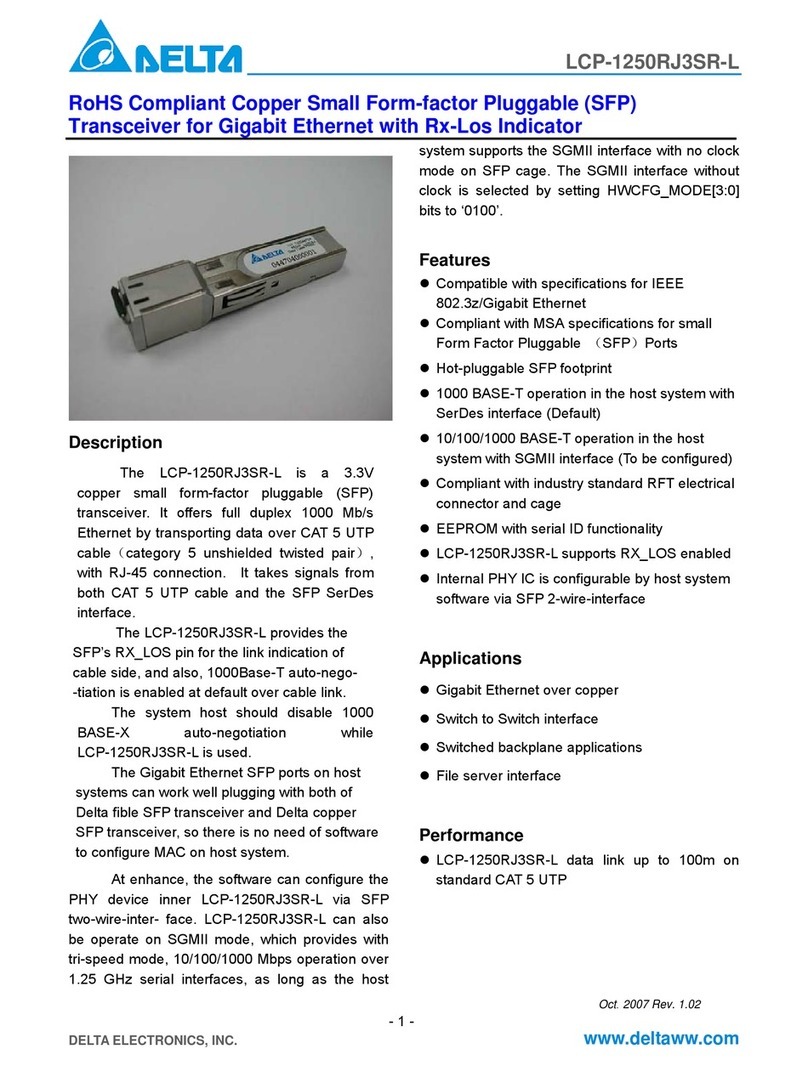
Delta Electronics
Delta Electronics LCP-1250RJ3SR-L Specification sheet
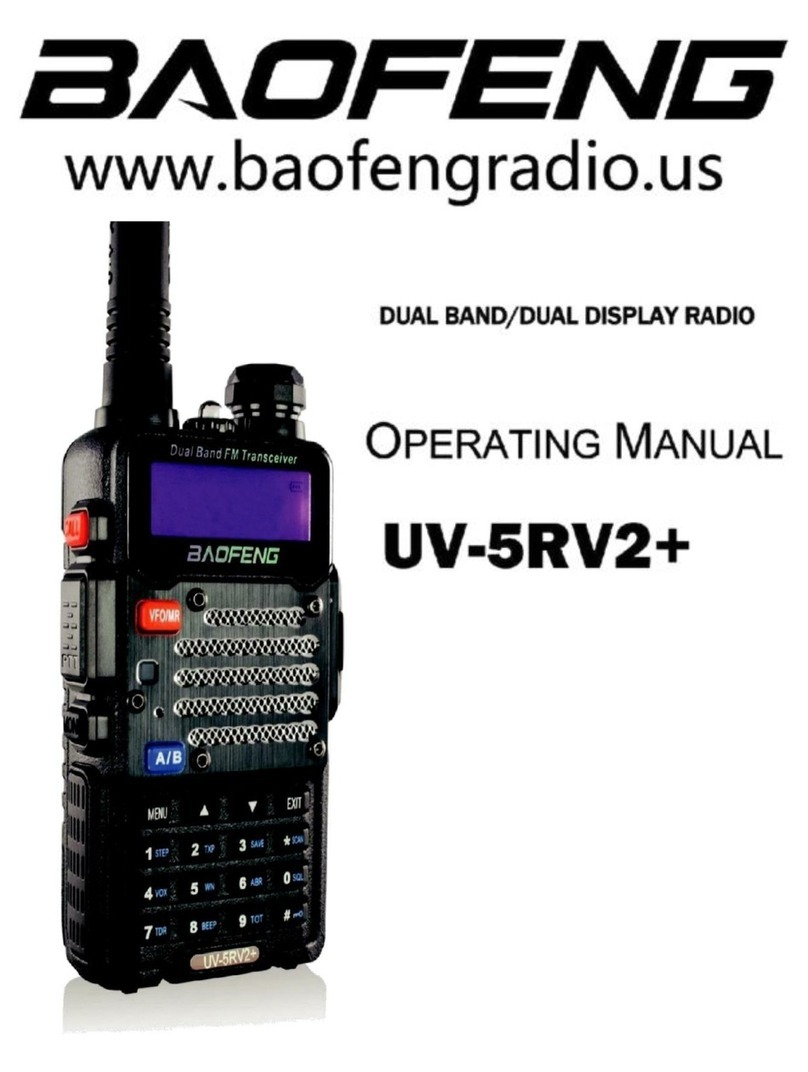
Baofeng
Baofeng UV-5RV2+ operating manual

MFJ
MFJ MFJ-9406 instruction manual
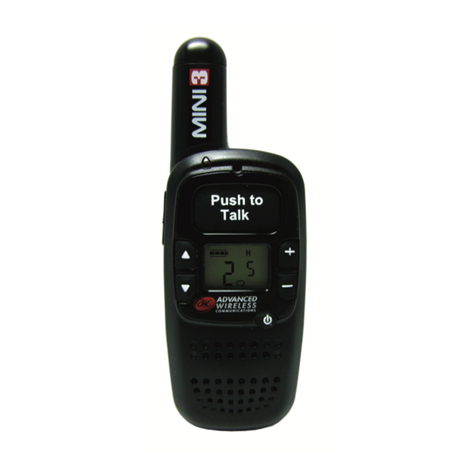
Advanced Wireless Communications
Advanced Wireless Communications Mini 3 quick start guide
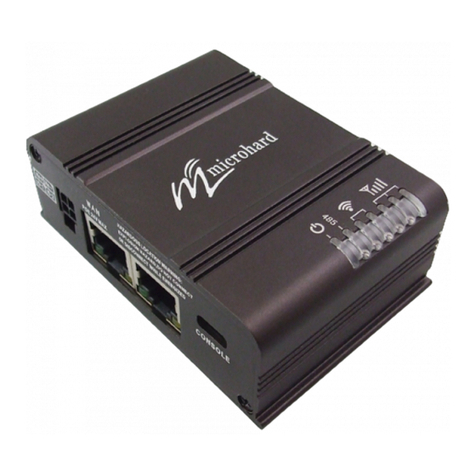
Microhard Systems
Microhard Systems pMDDL2450 operating manual
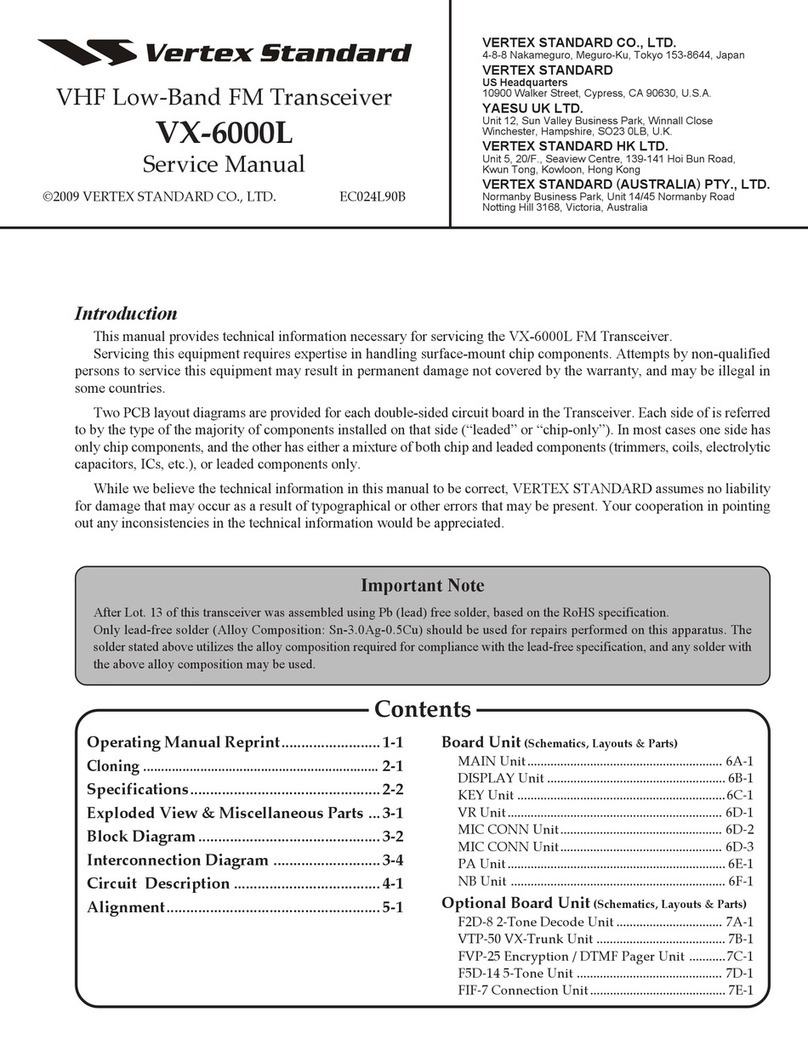
Vertex Standard
Vertex Standard VX-6000L Service manual

